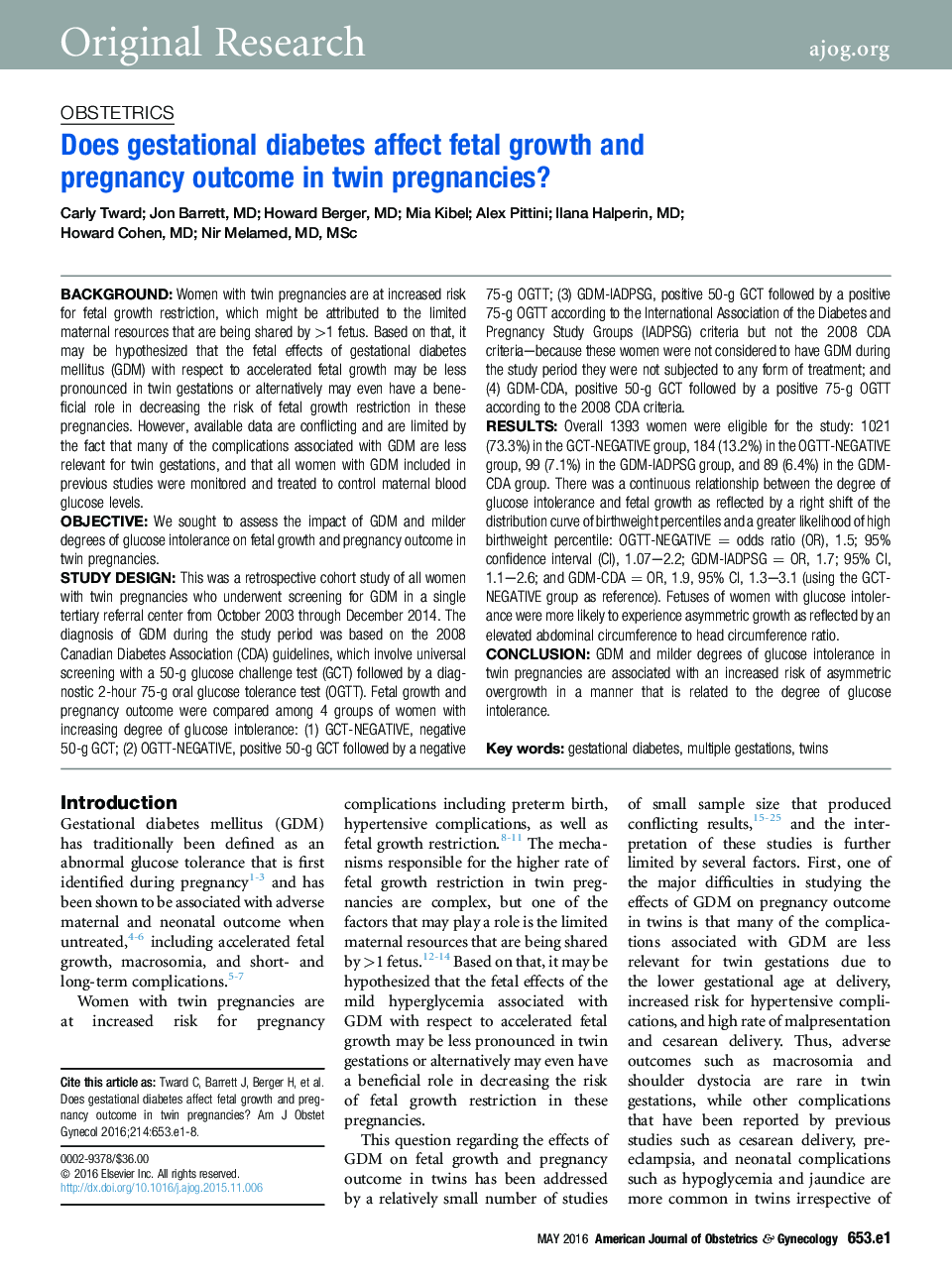| کد مقاله | کد نشریه | سال انتشار | مقاله انگلیسی | نسخه تمام متن |
|---|---|---|---|---|
| 6144058 | 1594891 | 2016 | 8 صفحه PDF | دانلود رایگان |
BackgroundWomen with twin pregnancies are at increased risk for fetal growth restriction, which might be attributed to the limited maternal resources that are being shared by >1 fetus. Based on that, it may be hypothesized that the fetal effects of gestational diabetes mellitus (GDM) with respect to accelerated fetal growth may be less pronounced in twin gestations or alternatively may even have a beneficial role in decreasing the risk of fetal growth restriction in these pregnancies. However, available data are conflicting and are limited by the fact that many of the complications associated with GDM are less relevant for twin gestations, and that all women with GDM included in previous studies were monitored and treated to control maternal blood glucose levels.ObjectiveWe sought to assess the impact of GDM and milder degrees of glucose intolerance on fetal growth and pregnancy outcome in twin pregnancies.Study DesignThis was a retrospective cohort study of all women with twin pregnancies who underwent screening for GDM in a single tertiary referral center from October 2003 through December 2014. The diagnosis of GDM during the study period was based on the 2008 Canadian Diabetes Association (CDA) guidelines, which involve universal screening with a 50-g glucose challenge test (GCT) followed by a diagnostic 2-hour 75-g oral glucose tolerance test (OGTT). Fetal growth and pregnancy outcome were compared among 4 groups of women with increasing degree of glucose intolerance: (1) GCT-NEGATIVE, negative 50-g GCT; (2) OGTT-NEGATIVE, positive 50-g GCT followed by a negative 75-g OGTT; (3) GDM-IADPSG, positive 50-g GCT followed by a positive 75-g OGTT according to the International Association of the Diabetes and Pregnancy Study Groups (IADPSG) criteria but not the 2008 CDA criteria-because these women were not considered to have GDM during the study period they were not subjected to any form of treatment; and (4) GDM-CDA, positive 50-g GCT followed by a positive 75-g OGTT according to the 2008 CDA criteria.ResultsOverall 1393 women were eligible for the study: 1021 (73.3%) in the GCT-NEGATIVE group, 184 (13.2%) in the OGTT-NEGATIVE group, 99 (7.1%) in the GDM-IADPSG group, and 89 (6.4%) in the GDM-CDA group. There was a continuous relationship between the degree of glucose intolerance and fetal growth as reflected by a right shift of the distribution curve of birthweight percentiles and a greater likelihood of high birthweight percentile: OGTT-NEGATIVE = odds ratio (OR), 1.5; 95% confidence interval (CI), 1.07-2.2; GDM-IADPSG = OR, 1.7; 95% CI, 1.1-2.6; and GDM-CDA = OR, 1.9, 95% CI, 1.3-3.1 (using the GCT-NEGATIVE group as reference). Fetuses of women with glucose intolerance were more likely to experience asymmetric growth as reflected by an elevated abdominal circumference to head circumference ratio.ConclusionGDM and milder degrees of glucose intolerance in twin pregnancies are associated with an increased risk of asymmetric overgrowth in a manner that is related to the degree of glucose intolerance.
Journal: American Journal of Obstetrics and Gynecology - Volume 214, Issue 5, May 2016, Pages 653.e1-653.e8
